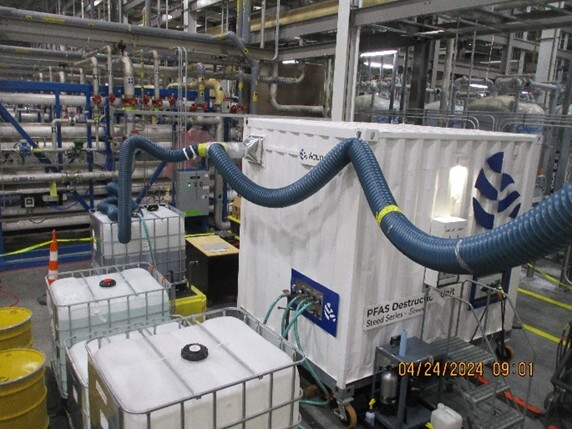Recent Customer Case Studies
Military Sites
AFFF Stockpiles
Disposal of concentrated AFFF is a challenge due to mounting technical and regulatory concerns. Historically, AFFF concentrates have been incinerated, but recently the DoD released a temporary moratorium on the incineration of AFFF.
We recently partnered with an AFB to treat AFFF concentrates. For the full range of PFAS measured, >99.99% of PFAS was destroyed.
We recently partnered with an AFB to treat AFFF concentrates. For the full range of PFAS measured, >99.99% of PFAS was destroyed.
Untreated
(ppm)
HALT Treated
(ppm)
PFOS
26,200
0.06
PFOA
268
0.009
PFHxS
4,380
0.5
PFHpS
563
0.006
PFBS
438
0.3
PFHxA
241
0.003
Total PFAS
32,830
1.3
40 PFAS analytes measured.
Military & Airports
Fire Training Pond Water
AFFF used for fire training accumulates in pit water on-site. This results in high concentrations of PFAS, large treatment volumes, and other water quality parameters impacting treatment.
We recently partnered with an airport to conduct a continuous pilot study for treating fire training pit water. For the full range of PFAS measured, >99.91% of PFAS was destroyed.
We recently partnered with an airport to conduct a continuous pilot study for treating fire training pit water. For the full range of PFAS measured, >99.91% of PFAS was destroyed.
Untreated
(ppb)
HALT Treated
(ppb)
PFOS
1,045
1.4
PFOA
414
0.01
PFHxS
240
0.5
PFHpS
19
0.04
PFBS
59
0.1
PFHxA
94
0.015
Total PFAS
2,424
2.3
28 PFAS analytes measured.
Landfills
Leachate and soil
We recently treated both raw leachate and a foam fractionate from in-situ soil treatment.
For the full range of PFAS measured, >99.8% of PFAS was destroyed in the raw leachate and >98.9% was destroyed in the fractionate.
For the full range of PFAS measured, >99.8% of PFAS was destroyed in the raw leachate and >98.9% was destroyed in the fractionate.
Untreated
(ppb)
HALT Treated
(ppb)
PFOS
8,060
137
PFOA
1,256
7
PFHxS
3,140
22
PFHpS
236
3.6
PFBS
45
2.3
PFHxA
134
1.3
Total PFAS
18,101
182
28 PFAS analytes measured. Data provided above from foam fractionate sample.









